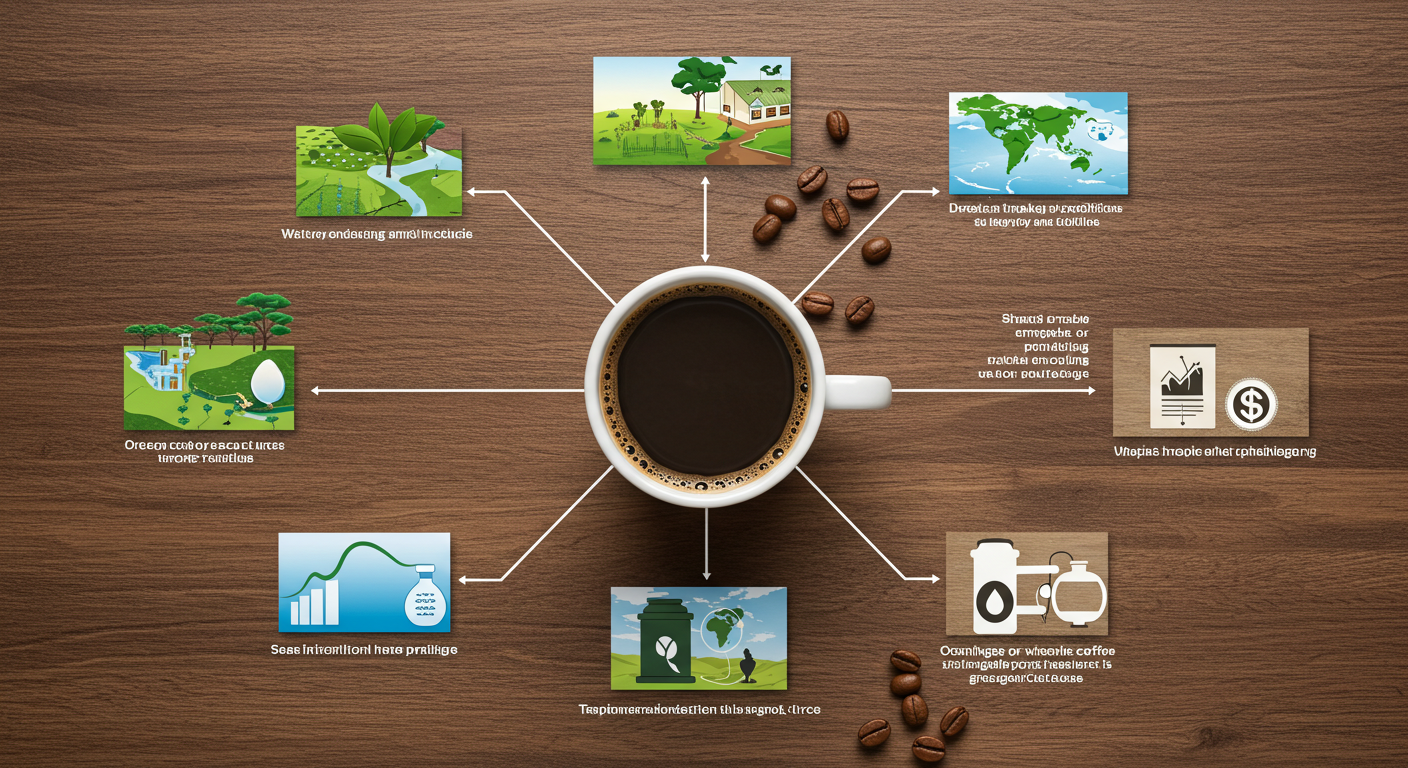Coffee is one of the most beloved beverages in the world — but behind every cup lies a complex supply chain with real environmental consequences. From deforestation to water usage and carbon emissions, coffee production can take a toll on the planet.
This article explores the environmental impact of coffee, the challenges the industry faces, and how you — as a conscious consumer — can make more sustainable choices.
The Lifecycle of a Coffee Bean
To understand its impact, we need to look at the full lifecycle of coffee:
- Growing – primarily in tropical regions known as the “coffee belt”
- Harvesting and Processing – removing the coffee cherry’s pulp and drying the beans
- Roasting – turning green beans into the brown ones we know
- Packaging and Transport
- Brewing and Waste Disposal
Each stage has an environmental footprint.
1. Deforestation and Land Use
Coffee farming is a leading cause of deforestation, especially in Latin America, Southeast Asia, and parts of Africa.
- Forests are cleared to make room for coffee plantations.
- This loss of trees reduces biodiversity and contributes to carbon emissions.
Sun-grown coffee, which favors high-yield but intensive production, often causes more damage than shade-grown coffee, which supports forest canopies and wildlife.
2. Water Consumption
Producing one cup of coffee requires an estimated 140 liters (37 gallons) of water. This includes:
- Water for growing the plants
- Water used during bean processing
In water-scarce regions, this can contribute to serious sustainability issues. Traditional wet-processing methods use a lot of water and can also lead to water pollution if waste isn’t managed properly.
3. Pesticides and Chemicals
Many conventional coffee farms use:
- Synthetic fertilizers
- Herbicides
- Pesticides
These chemicals can contaminate soil and waterways, harm local communities, and impact the health of farmworkers.
Organic farming avoids synthetic chemicals, but it’s not always accessible for small farmers due to cost.
4. Carbon Emissions
From transporting green beans across continents to roasting and packaging, coffee’s global demand adds to its carbon footprint.
Key emissions sources:
- Farm machinery
- Shipping (especially long-distance)
- Energy-intensive roasting
- Single-use packaging and brewing devices (like pods)
5. Waste from Single-Use Coffee Products
The popularity of convenience options like:
- Coffee pods
- Takeaway cups
- Plastic stirrers and lids
…has created a massive waste issue. Most single-use cups are not recyclable due to plastic linings, and pods often end up in landfills.
Did you know?
Globally, we use over 16 billion disposable coffee cups each year — and most are not recycled.
Sustainable Solutions for the Industry
1. Shade-Grown Coffee
Encouraging the return to agroforestry — growing coffee under tree canopies — supports:
- Biodiversity
- Soil health
- Carbon sequestration
2. Organic and Regenerative Farming
These methods avoid synthetic chemicals and promote soil regeneration and eco-friendly pest control.
3. Fair Trade and Ethical Certifications
Programs like:
- Fair Trade
- Rainforest Alliance
- UTZ
…ensure better environmental practices and fair wages for farmers. While not perfect, these labels can guide consumers toward better choices.
4. Water-Saving Processing Techniques
Some producers now use:
- Dry processing (which uses little to no water)
- Eco-pulpers that save up to 90% of the water used in traditional washing
5. Sustainable Packaging
More coffee brands are switching to:
- Compostable bags
- Recyclable or reusable containers
- Bulk purchases to reduce waste
What You Can Do as a Consumer
You don’t have to give up coffee — just drink it more mindfully. Here’s how:
✅ Choose Sustainable Brands
Look for labels like:
- Organic
- Fair Trade
- Bird-Friendly
- Rainforest Alliance
✅ Avoid Coffee Pods
Brew with a French press, drip, or espresso machine instead. If you must use pods, choose recyclable or compostable ones.
✅ Bring Your Own Cup
Using a reusable travel mug significantly reduces waste.
✅ Buy Local and in Bulk
Support local roasters who source ethically and sell in bulk. It reduces shipping emissions and packaging waste.
✅ Compost Coffee Grounds
Used grounds are great for your garden or compost bin. Don’t toss them in the trash!
The Future of Sustainable Coffee
The industry is evolving:
- Tech innovations in processing
- Blockchain tracking for transparent supply chains
- Carbon-neutral roasting facilities
- Farmer-led cooperatives practicing regenerative agriculture
Consumers play a vital role. Your daily cup can influence demand, shape industry standards, and support more sustainable coffee practices worldwide.
Brew Better for the Planet
Coffee brings people together, fuels creativity, and energizes our days. But it also comes with environmental costs. The good news? With every purchase and sip, you have the power to support a more sustainable, ethical coffee future.
Let your love of coffee be a force for good — for people, and for the planet.


